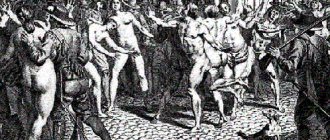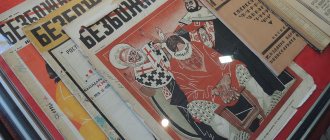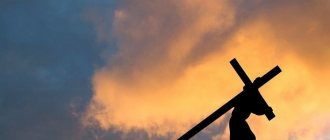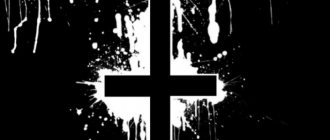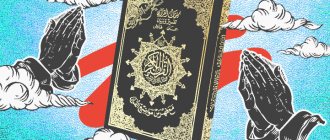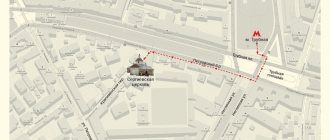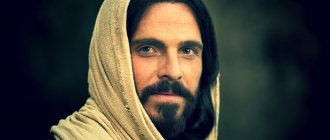Orthodox cross with crescent
It is also worth mentioning another form of the Orthodox cross. In this case, the cross has a crescent at its base. Such crosses very often crown the domes of Orthodox churches.
According to one version, the cross emerging from the crescent symbolizes the birth of the Lord Jesus Christ. In the Eastern tradition, the crescent is often considered a symbol of the Mother of God - just as the cross is considered a symbol of Jesus Christ.
Another interpretation explains the crescent as a symbol of the Eucharistic cup with the blood of the Lord, from which, in fact, the Cross of the Lord is born. There is another interpretation regarding the cross emerging from the crescent.
This interpretation suggests understanding this as a victory (or rise, advantage) of Christianity over Islam. However, as research has shown, this interpretation is incorrect, since the very form of such a cross appeared much earlier than the 6th century, when, in fact, Islam arose.
The Cross of Christ is the path, strength and banner of the Church
The dogmatic teaching of the Church has the closest connection with the entire moral structure of Christian life; it gives it the right direction. Any deviation from dogmatic truths leads to a misunderstanding of the moral duty of a Christian. Faith requires “living by faith.”
The Savior defined man's moral duty briefly in two commandments of the Law: the commandment to love God - with all the heart, with all the soul, with all the thought, with all the mind - and the commandment to love one's neighbor as oneself. But at the same time, the Savior taught that the true fulfillment of these commandments is impossible without self-denial to one degree or another, sacrifice: it requires heroism.
Where will a believer find the strength for achievement? He will receive them through communication with Christ, through love for Christ, prompting him to follow Him. Christ called this following in the feat “His yoke.” Take My yoke upon you... for My yoke is easy and My burden is easy
. He also called it a cross. Long before the day of His crucifixion on the cross, the Lord taught: If anyone wants to come after Me, let him deny himself and take up his cross and follow Me (Matthew 16:24).
“Whoever does not take up his cross and follow Me is not worthy of Me” (Matt. 10:38).
The Orthodox path of a Christian is the path of the cross and feat. In other words, this is the path of patience, enduring sorrows, persecution for the name of Christ and danger from the enemies of Christ, neglecting the blessings of the world for the sake of Christ, fighting one’s passions and lusts.
His apostles followed this path of following Christ. “I have been crucified with Christ,” writes St. Paul. “I do not desire to boast except in the Cross of our Lord Jesus Christ, by which the world has been crucified to me, and I to the world” (Gal. 2:19; 6:14). Following the path of Christ, the apostles ended their feat of life with martyrdom.
All believers are called to heroic deeds, to the best of their ability: Those who are Christ’s have crucified the flesh with its passions and lusts (Gal. 5:24). Moral life cannot do without internal struggle, without abstinence. “For many,” writes the apostle, “about whom I have often told you, and now I even tell you with tears, act like the enemies of the Cross of Christ: their god is their belly, and their glory is in their shame, they think about earthly things” (Phil. 3 :18–19).
The entire history of the Church was built on exploits: first on the sufferings of the martyrs of early Christianity, on the sacrificial labors of the pillars of the Church - the saints, and then on personal ascetic exploits, on the achievements of the spirit in the fight against the flesh of hermits and other ascetics - “earthly angels and heavenly people” and “ righteous” who lived in the world and were not defiled by the world. And this is how Christianity is decorated to this day with confessors and martyrs for faith in Christ. And the Holy Church supports in believers this duty of self-restraint and spiritual purification with instructions and examples from the Gospel and all Holy Scripture, examples of saints, instructions of the church charter, vigils, fasts and calls to repentance.
This is the lot not only of the individual Christian, but also of the Church itself as a whole: “To be persecuted for the cross of Christ,” as it is presented in the visions of the Apostle John the Theologian in the Apocalypse. The Church, for many periods of its history, endures completely open sorrows: persecution and martyrdom of its best servants - what one modern clergyman and church writer called “the harvests of God” - and in other periods, even during periods of apparent prosperity, it endures sorrows from internal enemies , from the unworthy lifestyle of its members, in particular, the people appointed to serve it.
This is how the dogma of the Cross is defined,
The cross is the path of the Christian and the Church.
But at the same time, he is also the strength of the Church. Looking with mental eyes “at the Author of faith and the Finisher of Jesus,” a Christian draws spiritual strength from the consciousness that the Lord’s death on the cross was followed by the resurrection, that the Cross “conquered the world,” that if we die with the Lord, then we will reign with Him at His appearing glory we will rejoice and be triumphant (1 Pet. 4:13).
The cross is, finally, the banner of the Church. From that day when the Savior carried the cross on His shoulder to Calvary and was crucified on a material cross, the Cross became a visible sign and sign of Christianity, the Church, and every believer in Christ.
Not everyone belonging to “broad Christianity” has this understanding of the Gospel. Some large Christian societies reject the Cross as a visible banner, believing that it, as it was, remains an instrument of desecration. The apostle warned against such “temptation of the cross.” Paul (Gal. 5:11) so as not to “make the Cross of Christ abolish,” for “the message of the Cross is foolishness to those who are perishing, but to us who are being saved it is the power of God” (1 Cor. 1:17–18). He exhorted not to be ashamed of the Cross as if it were a banner of reproach: “let us go out to Him (the Lord) outside the camp, bearing His reproach,” he instructed (Heb. 13:13-14). For the humiliation on the cross led to the resurrection in glory, and the Cross was the instrument of salvation and the path to glory.
Having always before him the image of the Cross, performing the sign of the Cross on himself, a Christian, firstly, brings to mind that he is called to follow the footsteps of Christ, enduring sorrows and hardships for his faith in the name of Christ; secondly, he is strengthened by the power of the Cross of Christ to fight evil in himself and in the world; and thirdly, he confesses that he is waiting for the appearance of the glory of Christ, the second coming of the Lord, which itself will be preceded by the appearance in heaven of the sign of the Son of Man, according to the divine words of the Lord Himself (Matthew 24:30): by this sign, according to the unanimous understanding of the Fathers of the Church, there will be a majestic appearance in the sky of the Cross.
Protopresbyter Mikhail Pomazansky
Athos Cross
There is another version of the Orthodox Crucifixion, the so-called full or Athos cross. It carries even more symbolic meanings. Its peculiarity is that certain letters are inscribed above the canonical six-pointed Cross.
What do the inscriptions on the cross mean?
Above the topmost crossbar is inscribed: “IS” - Jesus and “XC” - Christ. A little lower, along the edges of the middle crossbar: “SN” - Son and “BZHIY” - God. There are two inscriptions under the middle crossbar. Along the edges: “TSR” - King and “SLOY” - Glory, and in (translated from Greek - victory). This word means that with His suffering and death on the Cross, the Lord Jesus Christ conquered death and atoned for human sins.
On the sides of the Crucifixion are depicted a spear and a cane with a sponge, designated, respectively, by the letters “K” and “T”. As we know from the Gospel, they pierced the Lord’s right rib with a spear, and they offered Him a sponge with vinegar on a cane in order to relieve His pain. The Lord refused to alleviate His suffering. Below, the Crucifixion is depicted standing on the base - a small elevation, which symbolizes Mount Golgotha, on which the Lord was crucified.
Inside the mountain is the skull and crossbones of the forefather Adam. In accordance with this, on the sides of the elevation there is an inscription - “ML” and “RB” - Place of Execution and Crucified Byst, as well as two letters “G” - Golgotha. Inside Golgotha, on the sides of the skull, the letters “G” and “A” are placed - the head of Adam.
The image of Adam's remains has a certain symbolic meaning. The Lord, being crucified, sheds His blood on the remains of Adam, thereby washing and cleansing him from the fall he committed in paradise. Together with Adam, the sins of all humanity are washed away. In the center of the crucifix there is also a circle with thorns - this is a symbol of the crown of thorns, which was put on the head of the Lord Jesus Christ by Roman soldiers.
The cross is a symbol of Christianity
John of Damascus
“Where there is a sign, there He Himself will be.”
In one of my activities (sitting in a candle shop), I hear a lot of different questions. Including crosses.
Which one is correct? And if all are correct, then which one is the most Orthodox? What do the crossbars on the Crucifix mean? Why do Christians worship the Cross, an instrument of shameful and painful execution? Etc.
The coming Sunday, the third in Lent, is called the Worship of the Cross. On the eve of Saturday at the evening service the Cross will be taken out of the altar for veneration. Taking this opportunity, let's talk about it.
The cross is a very ancient symbol. It was found in Egypt, India, the Chinese, and many other ancient civilizations. The ancient Egyptian “ankh” (Fig. 1) meant the union of the heavenly and earthly, immortality, life, wisdom. The usual equilateral quadrangular cross among many peoples symbolized the four elements - fire, water, earth and air. The Indians marked vessels with holy Ganges water with this sign. Chinese lanterns with his image illuminated sacred places.
But Christians initially used another symbol - a fish. The Greek word “ichthyos” for them meant not only this animal, but was also a kind of encryption - it is an abbreviation of the phrase “Jesus Christ, Son of God, Savior.” The Jews did not use the cross as an instrument of execution. They had other ways to destroy their neighbors. The crucifix was brought to them shortly before Christ by the Romans. Slaves were subjected to painful execution on the cross in Rome itself, and in the conquered provinces also those who did not have Roman citizenship. Therefore, at first it caused nothing but horror. But already the Apostle Paul calls it “the power of God” (1 Cor. 1:18). “...I desire to boast (...) only in the cross of our Lord Jesus Christ” (Gal. 6:14) - he writes in his letter to the Galatians. That is, already in the 1st century, for Christians, the cross, from an instrument of torment and death, became a symbol of Life, because Christ, having died on it, was resurrected and conquered death.
By the way, this idea can be seen most clearly on Orthodox crucifixes. Among Catholics, the crucified Christ is depicted suffering, with his fingers cramped from unbearable pain, with a tragic or already sharpened face, like that of a dead man. Protestants often depict only one cross, interpreting it, first of all, as a symbol of Christianity, and not an instrument of death. On an Orthodox crucifix you will not see any physiology of torture. The face of Christ is calm and thoughtful, his outstretched arms seem ready to embrace the whole world. Looking at Him, you understand that after death (it is present in the form of five spots of blood at the site of the wounds) the Resurrection is coming.
The forms of the cross, both as a weapon and as a Christian symbol, were very different. Let's look at some from a second point of view. T-shaped, or “Antonian” (Fig. 2) - probably, two thieves were crucified on these at the same time as Jesus. X-shaped, or “Andreevsky” (Fig. 3). According to legend, Apostle Andrew ended his life there. Peter I placed his image on the Russian coat of arms, personal seal, naval flag, etc. The Tsar explained it this way: “The Cross of St. Andrew (accepted) for the sake of the fact that Russia received holy baptism from this Apostle.”
One of the oldest crosses found by archaeologists (III century) was monogrammatic; it combined the Greek letters I and X, with which the name of Jesus Christ begins (Fig. 4). The cross finally became a symbol of our faith under Constantine the Great (274-337). The cross that he saw in the sky before the decisive battle was also monogrammed. It consisted of the first letters of the word “Christ” (Fig. 5).
The eight-pointed, or Russian, cross is not only the most familiar to us (Fig. 6), it also most closely corresponds to the cross on which the Savior was crucified. The top crossbar is a sign with the inscription “Jesus of Nazareth, King of the Jews.” Pilate ordered her to be nailed to Christ's head. Usually the entire phrase is not written on crucifixes; they make do with the Church Slavonic abbreviation INCI, or the Latin INRI (Iesus Nazareus Rex Iudaorum) on Catholic crosses. The bottom crossbar is the foot. The convict stood on it, leaning his feet, which prolonged his torment. Why is the crossbar on our cross slanted? The right (from Christ) end points upward to the prudent thief, the same one who, before his death, asked “Remember me, Lord, when you come into Your kingdom” (Luke 23:42). The other end points down to hell, where the path lay after the death of another thief, who slandered Jesus until the last minutes of his life. Some scientists even name the materials from which the cross was made: the longitudinal beam was made of cypress, the cross beam was made of date palm, the base was made of cedar, the tablet with the inscription was made of olive wood.
Often, especially on the domes of churches, you can see a cross with a crescent (Fig. 7). This does not mean any violation of Islam. The crescent is the Bethlehem cradle, the Holy Chalice for Communion, the baptismal font, and the state sign of Byzantium. After the capture of Constantinople in 1453, this Christian symbol became the emblem of the Ottoman Empire.
Among Catholics and Protestants, the four-pointed, so-called, is common. "Latin" cross (Fig. 8). On Catholic crucifixes, Christ's feet are pierced together with a common nail. Why do Catholics portray the Crucified Savior this way? The fact is that in Rome they keep, as a sacred relic, three nails with which the Lord was crucified. And yet, if Christ's feet were nailed with just one nail, this would call into question the competence of the executioners of the first half of the 1st century AD. e. The point of execution by crucifixion was precisely so that the person condemned to it would not break under his own weight, but would suffer, nailed down. If the condemned man's feet were nailed to the step with one nail, the downward pressure would be much greater. Therefore, Christ's feet were nailed each with one nail to the step. Thus, the Convict rested evenly on both legs, resting and thereby prolonging the torment.
The square “Greek” cross (Fig. 9) is no less “Orthodox” than the Russian eight-pointed one. It can be seen in most Orthodox countries - Bulgaria, Romania, Serbia, and not only in Greece. By the way, crosses were of exactly this shape in pre-Mongol Rus'.
The Orthodox Church recognizes crosses of any configuration. For us, the main thing is not the number of nails and planks, but the sign itself, the sign itself. As John of Damascus said: “...where there is a sign, there He Himself will be.”
Peter Fokin, psalmist of the Church of the Sign
Six-pointed Orthodox cross
In Orthodoxy, a six-pointed crucifix is considered canonical: a vertical line is crossed by three transverse ones, one of them (the lower one) is oblique.
The upper horizontal crossbar (the shortest of the three transverse ones) symbolizes a tablet with an inscription in three languages (Greek, Latin and Hebrew): “Jesus of Nazareth, King of the Jews.” This tablet, by order of Pontius Pilate, was nailed to the Cross of the Lord before the crucifixion. The middle crossbar, shifted closer to the top (longest), is a direct part of the Cross - the hands of the Savior were nailed to it.
The lower oblique crossbar is a support for the legs. Unlike Catholics, in Orthodoxy on the Crucifixion both legs of the Savior are shown pierced by nails. This tradition is confirmed by studies of the Shroud of Turin - the cloth in which the body of the crucified Lord Jesus Christ was wrapped.
It is worth adding that the oblique shape of the lower crossbar carries a certain symbolic meaning. The raised end of this crossbar rushes upward to the sky, thereby symbolizing the thief crucified at the right hand of the Savior, who, already on the cross, repented and entered with the Lord into the Kingdom of Heaven. The other end of the crossbar, facing down, symbolizes the second thief, crucified on the left hand of the Savior, who blasphemed the Lord and did not receive forgiveness. The state of this robber’s soul is a state of God-forsakenness, of hell.

